How many times have you heard someone say, “Shooting a pistol is simple, it is just not easy?” Shooting a pistol should be easy — align the sights and press the trigger, right? Hitting a golf ball should be easy. You have a big stick and the ball is sitting still — should be easy. Doing either well, however, is not an easy thing to do. Let’s talk about some things you should know to simplify the process of shooting a pistol well.
Get the Right Pistol for the job
How do you decide which is the right pistol?
Write up a job description. What do you need to pistol to do? Is it for handgun hunting in Africa or squirrels in East Texas? Do you need it for bear defense while you are fishing in Alaska or bad-guy defense in your neighborhood?
Can you carry it in an exposed chest rig or does it need to be small enough to hide in deep concealment? Will it be the pride and joy of your BBQ gun collection, or does it need to be the simple and functional 22 LR your granddaughter learns to shoot with?
Each of these situations, along with countless others, is going to create a specific set of requirements. You are going to have to decide what your needs are and what meets those needs.
Combine the tasks the pistol is needed to perform with the physical stature of the shooter, and you can get an idea what the size of pistol should be. Keep in mind that hands and fingers vary greatly in width, length, and strength. Whatever size your hands are, they are what they are and you have to find pistols that fit your hand. Subtle changes can make a huge difference. For example, try changing the grip insert on your SIG/Smith & Wesson/Glock/FN/XD/Ruger, etc. Frequently, the large insert will feel best, but many find that the medium or even small insert gives the best trigger control.
How much recoil can you handle? A little bit of realism is a good thing. We are stating the obvious but, the larger the caliber and the smaller the pistol, the greater the recoil will be. The shooter who purchases a pistol that generates recoil above their recoil threshold, whatever level that is, will seldom shoot the pistol and almost never practice with it.
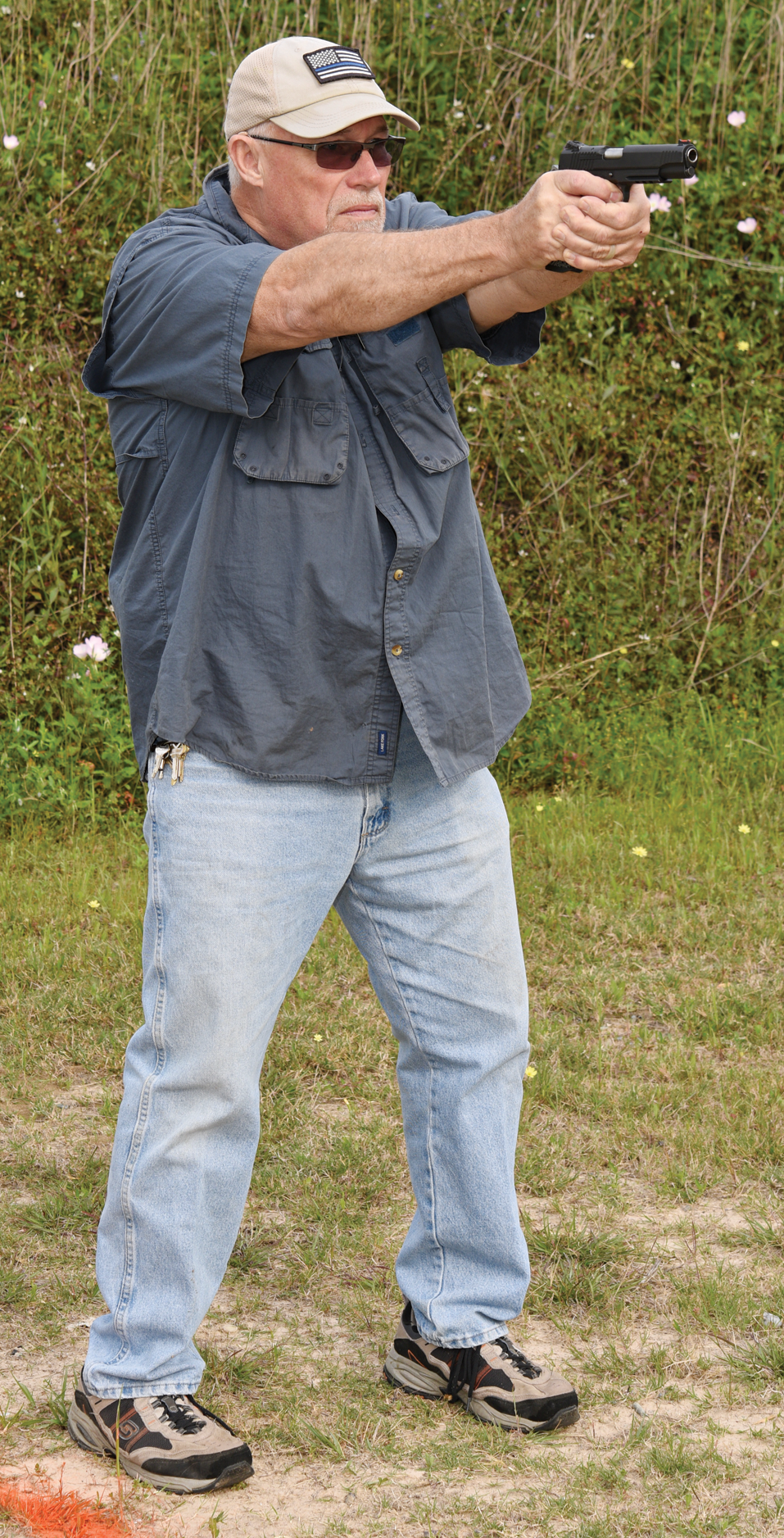
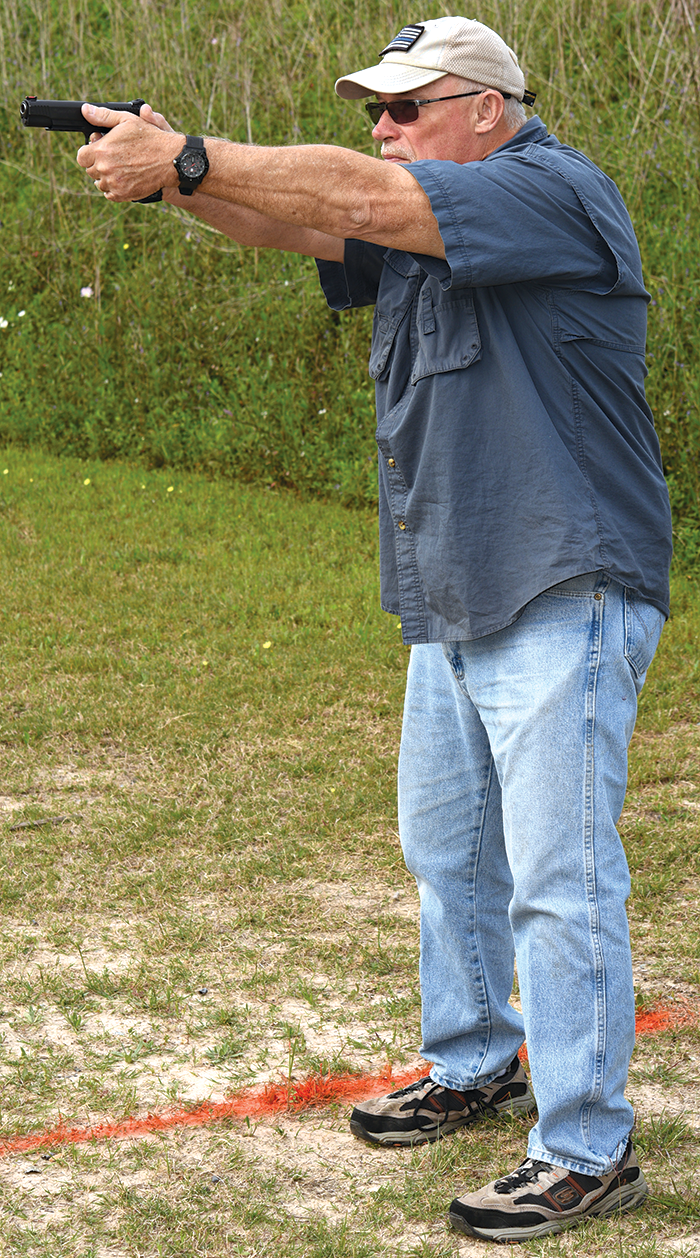
Reading Gun Tests evaluations closely can give you some ideas about what guns you might like, but the only way you can find out for sure is to shoot the guns! Talk to your local instructors and shooting ranges. Find out who has a selection of pistols you can test drive. Actual experience with the firearms allows you to make more informed decisions about what can be very expensive and important purchases.
Factors to consider about the purchase are single action vs. DA/SA vs. Safe Action. Each has their advantages and disadvantages. Also, thumb safeties vs. trigger safeties vs. internal safeties only? Ammunition capacity? Single stack vs. double stack magazines? The best advice is to shoot various choices under the tutelage of a good instructor and decide which you like best.
Getting The Right Stance
Anyone who thinks shooting is not an athletic event hasn’t done much shooting. Just like virtually every other athletic endeavor, your base is all important. Start with your stance. Are there multiple ways you can stand? Yes. Do several of those ways work? Yes. Try a variation on the following:
- Feet shoulder width apart.
- Strong-side foot not quite as far forward as the support-side foot. Not much less though. Try lining the toes of the strong-side foot up even with the middle of the arch of the support side — remember, still shoulder width apart.
- Flex the knees slightly. Just unlock them. That allows the shooter to turn and move much more easily. It also does wonders for circulation. Remember all those groomsmen that pass out on the Sunday night video show? They locked their knees and passed out. Don’t do that.
- Get your nose out over your toes. If you get your center of gravity, i.e. your weight, forward, you will work from a much more stable shooting platform and recoil will affect you less. You want to lean just far enough forward where it feels like your heels want to come off the ground.
The Grip
The handgun must go in the hand. How you do that is even more important than the way you stand. Once again, there is more than one way to hold a pistol that will do the job you need done.
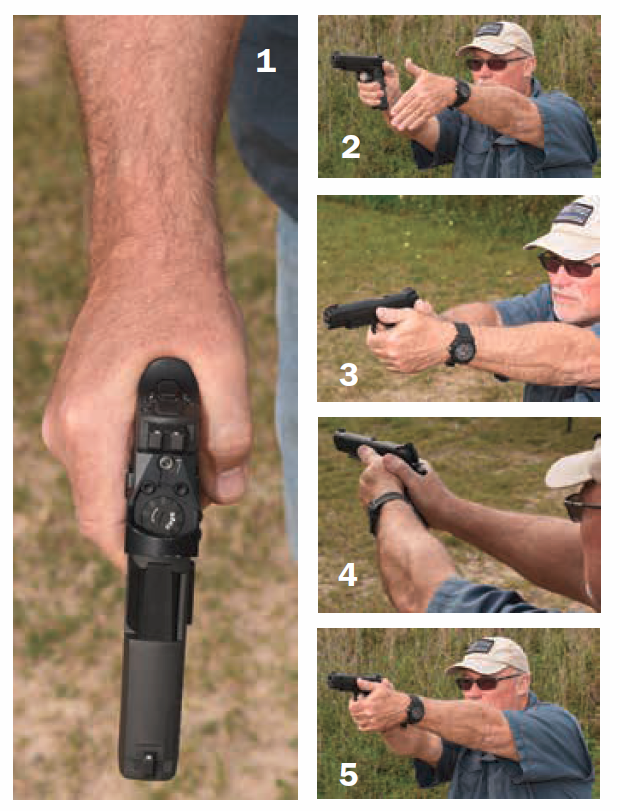
Some good guidelines are:
- Grip the pistol as high as you can. That is normally going to be determined by the 2nd knuckle on the middle finger running into the bottom of the trigger guard. Those who shoot a pistol very much will wind up with a nice callous right there. So don’t worry if that happens. The high grip will help you control the pistol and bring it back down from recoil more quickly for follow-up shots. Understand that firing the pistol will generate the same amount of recoil energy no matter where you grab it, but securing that high hold will lessen how much recoil it feels like it is generating.
- Upon grabbing the pistol, try to line it up in your hand where it just continues as a straight line pointing down along the axis of your arm. This helps with a natural alignment of the pistol and can really be helpful if any type of point shooting is required. Proper fit of the handgun to your hand is very important here. If the handgun is too large for your hand, you will not be able to put the pistol in your hand correctly and, simultaneously, activate the trigger correctly. The pistol must then be rotated in the hand until the finger can be placed on the trigger in such a way as to allow the trigger to be pressed straight to the rear.
- Grip the pistol — hard!
- If you are holding the pistol with one hand, the thumb should wrap around the grip and end up somewhere near the tip of the middle finger.
- If you are holding the pistol with two hands — infinitely preferable to one hand — get as much contact on the grip of the pistol as possible with both hands. The ball of the thumb on the support hand should contact the grip directly. That requires you get the strong-side thumb out of the way. Grasp the pistol first with the strong hand then “flag” the thumb. Point it up toward the sky and out of the way. Now the way is open for your support hand to grab the pistol and contact the grip as well. At this point lay the strong-side thumb down on the ball of the support-side thumb and ease the strong-side thumb “outboard” — slightly away from the pistol’s slide.
- Grip the pistol — hard!
- Hold the pistol hard with your strong hand. Hold it even tighter with the support hand. Done properly, you now have both thumbs pointing toward the target, allowing you to index your sights on the target naturally.
- Next, cam/bend the support hand down from the wrist at about a 30-degree angle. At this point, the shooter should have both arms and the strong hand pointed directly at the target. Angling the support hand properly puts downward pressure on the bottom fingers of the strong hand and further aids in recoil control.
- Arms should be fully or almost fully extended.
- Elbows should be rotated where the inner arms are facing toward each other instead of toward the sky.
- Grip the pistol — hard!
Align the Sights with the Target
Most pistols have some variation of a post in a notch. That means that you have three different things you are trying to look at while you shoot — the rear sight, the front sight, and the target. The problem is, a human eye can only focus on one thing at a time. So choose to focus on the front sight if you can. The rear should be fuzzy. The target should be fuzzy. The front sight should be crystal clear.
Bring the pistol up to your eye and look through the rear-sight notch. Don’t take your head down to the gun.
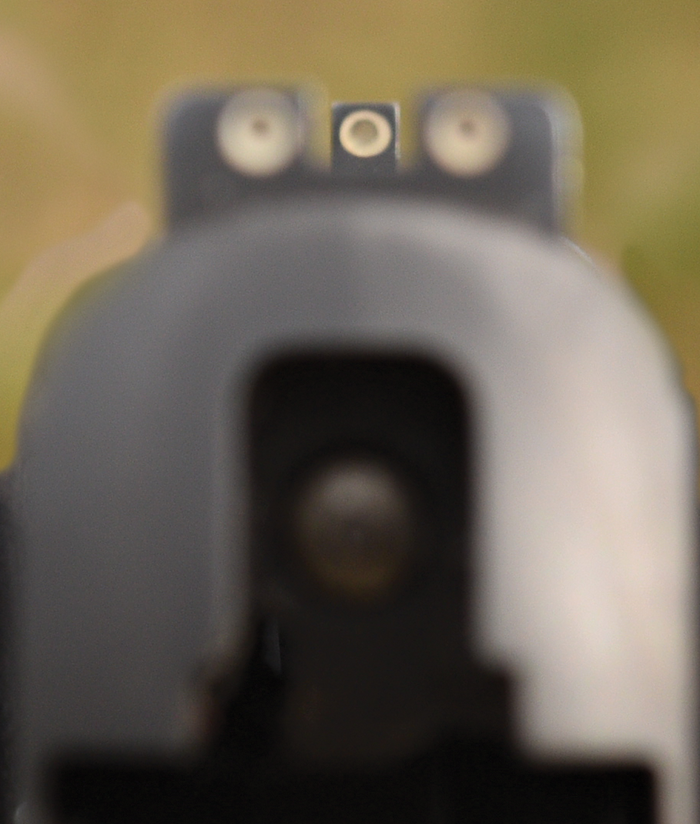
As you look through the rear-sight notch, move the muzzle around until you can see the front sight through the notch.
Line the front sight up where the top of the front sight is even with the top of the rear sight and an equal amount of light shows around the edges of the front sight. In other words, center the front-sight post in the rear-sight notch.
In most cases, you want to center the front sight in the rear sight, with the top of the front sight even with the top of the rear sight and align the top of the front sight on the exact point on the target you want to shoot.
Trigger Activation the Right Way
Anybody can align the sights. Anybody can activate the trigger. Can you activate the trigger in such a way that the alignment of the sights is not disturbed until the bullet leaves the muzzle? Therein lays the problem with a rifle or a pistol, but especially a pistol. You don’t have four to six points of contact with the firearm when you are shooting a pistol as you do with a rifle. You don’t have 6 to 16 pounds of weight extending 3 or 4 feet in front of you to help soak up any mistakes you make. You have to activate the trigger smoothly — without disturbing the alignment of the sights. How to do that?
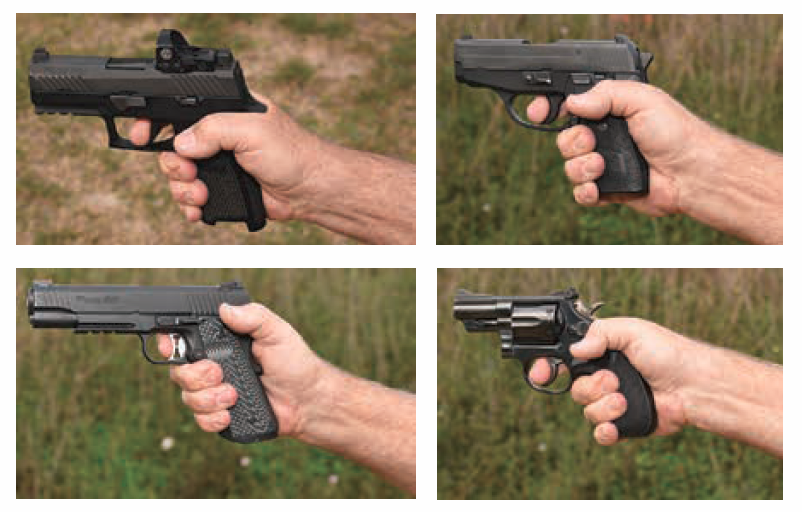
There are multiple theories about finger placement on the trigger of a handgun and what is required for smooth activation of that trigger. Ignore them and concentrate on you. Required finger placement on the trigger varies from person to person and gun to gun. Hand size and shape, finger length and strength, grip dimensions and reach to the face of the trigger, trigger weight, smoothness and length of pull can all change where your finger needs to go on a particular trigger.
Your finger’s job is to press the trigger straight and smoothly to the rear — period. As long as your finger accomplishes that, where it is placed on the trigger is irrelevant. Are there limits to where you can place a trigger finger and still have it do its job? Of course. But as long as your sights are aligned correctly, you press the trigger smoothly to the rear in a way that the sights stay lined up and everything else is set up correctly, the odds are really good things are going to go well.
- If you put too little finger on the trigger, you will normally push the shot toward your support side on the target.
- If you have too much finger, the shot is normally hooked toward your strong side.
- Experiment. Find where your finger needs to go on each gun that allows you to press the trigger straight to the rear.
How you press the trigger is irrelevant — as long as you don’t disturb the alignment of the sights. For example, slapping the trigger is generally a bad idea. But there are some absolutely incredible pistol shooters out there, such as Rob Leatham (one of the best pistol shooters ever), who really look like they slap the trigger, and it works for them. Remember, if it is stupid but it works, it ain’t stupid.
There are several good concepts that will help you activate the trigger correctly:
- 1911-style handguns have triggers that run in a track straight to the rear, thereby aiding your efforts to press them straight to the rear.
- Try putting your finger on the trigger where about one-quarter inch protrudes past the trigger. Take up what little slack (movement of the trigger that doesn’t actually do anything) there is and press through.
- Your finger stays in contact with the trigger and allows it to almost immediately return all the way forward.
- Repeat as necessary.
- Safe-action (Glock) and similar triggers are hinged and travel an arc as they are pressed. Most will allow considerable movement before the sear is released. The shooter can frequently take the slack up (move the trigger) until increased resistance is met (you reach the “pressure wall”). You can pause there and then complete the trigger press. Or not. That might be a good technique for a precise, slow shot but not one that you would be able to complete in a hurry.
- If at all possible, learn to place the finger on the trigger in a manner that allows the trigger to be pressed directly to the rear and then activate that trigger in a smooth, continuous stroke. The finger stays in contact with the trigger after the shot is fired and allows the trigger to return all the way forward. Once again, repeat as necessary.
Understand that the sights are not going to stay aligned on one particular spot on the target. The sights will wobble around. The amount of movement you have is called your “wobble zone.” Superman has a wobble zone, so don’t think you will be any different. The better your technique and the more you practice, the smaller your wobble zone will be. Accept it. Learn to align your sights somewhere near your point of aim on the target and then press the trigger smoothly. Jerking or slapping the trigger the precise and fleeting moment the sights are lined up perfectly will almost guarantee you will miss. Press the trigger smoothly, straight to the rear.
The only part of your body that gets to move while you are activating the trigger is the trigger finger. The shooting-hand grip must remain rock solid during trigger press. If you tighten the hand at the same time you press the trigger, your shots will most likely string vertically up and down the target, especially below your point of aim.
Fine Point of Sighting
For years instructors and competitors have been teaching neophyte shooters “Front Sight, Front Sight, Front Sight” as the absolute answer to all challenges in shooting a pistol. While this article, based on decades of my experience and a lot of training from some truly gifted instructors, opines that your trigger control is more important than what you do with the front sight, it does not suggest that your front sight is not important.
Unless you employ some other type of sighting system (red dot, scope, etc.) on your pistol, you are going to rely on those sights to tell you where your pistol is pointed and to help you point the pistol in the right place.
The sights must be calibrated for that gun, that ammo and that distance. Any change to one of those variables will likely change point of impact and require that the sights be recalibrated.
You focus on the front sight with the goal being to see where the front sight is in relation to the target the nanosecond the pistol fires.
That means you have to keep your eye/eyes open to see where the sights are when the pistol goes bang.
If possible, keep both eyes open. Like most good fundamentals, this skill can take some time to develop.
Every article like this needs to have a little bit of “Zen” included, so here goes — look at the front sight, focus on the front sight, watch the front sight as it moves in recoil, but concentrate on the trigger and the way you are pressing it straight to the rear. Other than to aim the pistol, the ultimate purpose of the front sight is to provide feedback on whether or not you are activating the trigger correctly. If you are watching the front sight as the pistol fires and you anticipate the recoil or slap the trigger, you will see the front sight move before the gun actually fires. If you are watching the front sight and tighten your grip as your press the trigger, you will see the front sight dip. Your front sight will tell you what you are doing with the trigger, right or wrong, if you will just watch it.
Watching your front sight as the pistol fires can/will also tell you if you hit the target and, probably, where you hit the target, without, necessarily, having to look at the target.
There are several exercises to help develop this skill. One is to fire the shot making sure that you see where the front sight is as the gun fires. Then close your eyes immediately. You should still have a visual image of what your sight picture looked like as the pistol fired. Based on that, call your shot. Out loud or quietly to yourself only doesn’t matter, but call where you think the shot will be. High, left, good shot, etc. Then open your eyes and compare what you saw in your mind’s eye with where the bullet actually hit the target. It takes lots of practice, but this can be an incredible skill to develop as your shooting improves.
Controlling Recoil
You align the sights perfectly and press the trigger smoothly, straight to the rear. The pistol fires and your bullet center punches the bullseye. Outstanding! Great job! Now get back to work — your job is not done yet. You need to deal with the recoil.
It doesn’t matter who you are, your pistol is going to recoil when it fires. Your size, muscle mass, and technique along with the weight of the pistol, the cartridge and how hot that cartridge is loaded are all going to be contributing or mitigating factors of the recoil, but the pistol is going to move.
Remember the previous comment about watching the front sight the nanosecond the gun goes bang? Watch the front sight after the gun goes bang as well. Watch that sight lift in recoil and keep watching it as you bring the pistol back down out of recoil and intentionally, consciously place the front sight back on the target for the next shot.
Even if the situation only calls for firing a single shot, follow through and bring the pistol back down for another shot. The human brain, programmed in that instant for a single shot, tends to relax as the shot is fired. That means the muscles relax, potentially before the bullet leaves the muzzle. That can cause minor and even major variations in where the bullet strikes the target.
Fire the shot, watch the sight lift in recoil and follow through to place that sight back on the target as expeditiously as possible. Now, after you make the conscious decision that no more shots are needed, dismount the firearm. Put the pistol back on the bench, take it back to a ready position or put it carefully back in the holster, but only after you are sure you don’t need it anymore.
Practice Makes Permanent
You don’t have to practice — unless you want to improve. Actually, you have to practice just to maintain whatever skill level you currently have. Remember that practice does not make perfect. Practice makes permanent. So, unless you practice the right skills correctly, all you do is ingrain bad habits that take even longer to unlearn.
The amount of practice required is relative to the skills desired. The average shooter will benefit greatly expending 50 rounds of ammunition, twice a month in a properly designed practice. High-level competitive pistol shooters average more than 1000 rounds per week in practice. What are your goals? What do you need to do to reach them?
You don’t have to practice exclusively with your fire-breathing hand cannons unless you are going to Africa next week. Full-metal-jacket practice ammo or properly loaded reloads will suffice quite nicely.
Try practicing with a 22 LR that is similar to your carry/match/whatever pistol. The 22 will not be a perfect substitute for the larger-caliber pistol, but it will require that you employ the same fundamental skills to shoot it.
Reloading your ammunition will probably not save you money, but it will let you shoot a lot more for the same budget.
Dry fire (work carefully with an unloaded firearm) more than you live fire. This is where you learn and test new skills. Get a good book, a good friend who knows what they are doing or a good instructor and learn how to do this correctly.
Start off practicing, dry fire and especially live fire, slowly and smoothly. These are conscious actions where you need to be aware of everything you are doing. Analyze the results of what you see and feel. The next current “in” method you try may fail miserably for you, and it might elevate your entire game. Don’t be afraid to experiment — slowly and smoothly.
The goal of practice is to be able to execute required/desired skills on demand and without conscious thought. Progressing from slowly and smoothly to subconscious competence takes time and, frequently, thousands of repetitions executed carefully. But it all boils down to the same fundamental skills. Remember that expertise is merely basics done well.
Free weights, even light ones, can be a very helpful part of your training routine. Arms extended straight forward while holding light weights, forearm and reverse forearm curls, and biceps curls can all help with many parts of your shooting game.
Some Additional Thoughts and Hints
When shooting a pistol, the secret to breathing is, yes, to breathe. Try inhaling slowly as you prepare to fire.
With all the talk earlier about “gorilla gripping” the pistol, don’t let your muscles tighten up past the elbows. Your shoulders neck and back should be loose and fluid.
Shoot with somebody better than you. Losing provides marvelous incentive to improve.
If you really want to learn to shoot, compete. There are several disciplines available for competing with a pistol — USPSA, IDPA, NRA Bullseye, SASS, 3 Gun and more. You don’t have to be an expert to compete. But you do have to be safe.
People in the shooting sports tend to be very accepting of new shooters and are very helpful. I have literally walked up to a world champion after he finished a stage and asked him why he ran the stage that particular way. He stopped and explained it to me.
There is a lot of information on the internet that can help. There is a lot more that can hurt.
Get good information, good gear and get started. We’re on your side.
Written by Joe Woolley. Photographed by Roger Eckstine.



























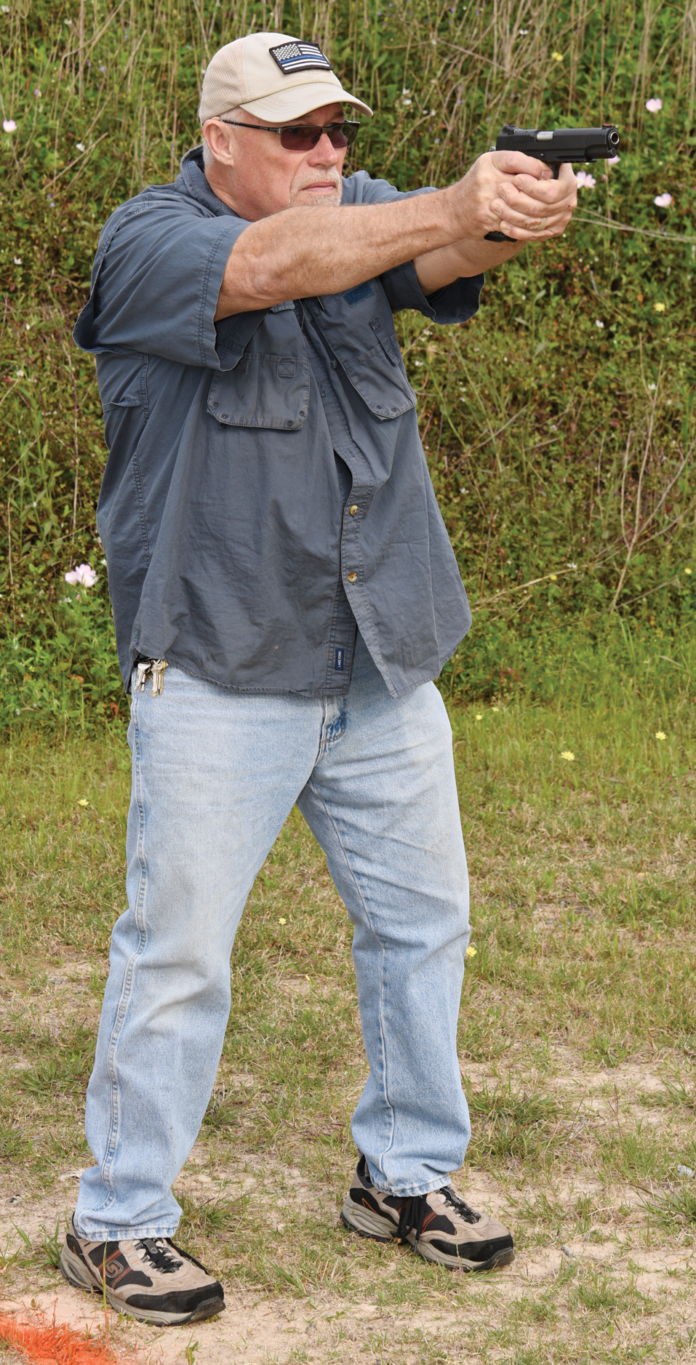




I purchase online concealed carry it’s not the right state I think it was Virginia and I live down in Florida. My friend is a police officer down in Florida and he said that I wasted money on a concealed carry. I’m going to get my concealed carry where I practice shooting in my state thank you very much I’m excited to have the gun. Thank you William noon
This was the most complete and informative article on pistol shooting fundamentals that I have seen. I have been reading and shooting for many years, and I learned some new things and some good things to try.
Thanks
Very good article, need to read it more than once. Forwarded to my children.
Thanks for this information.